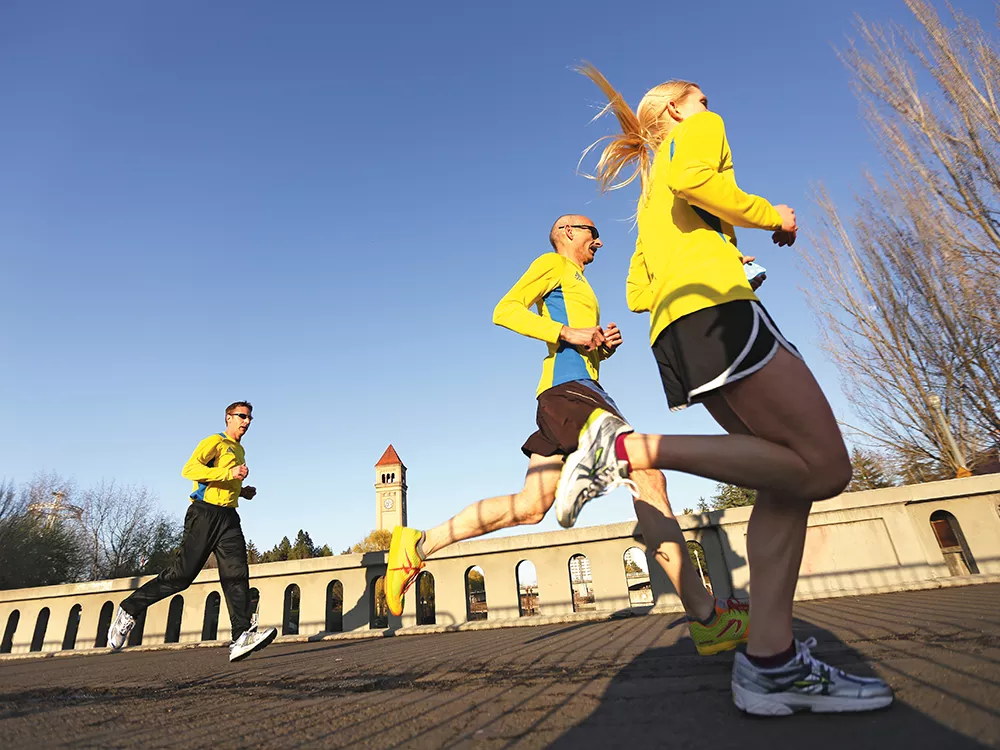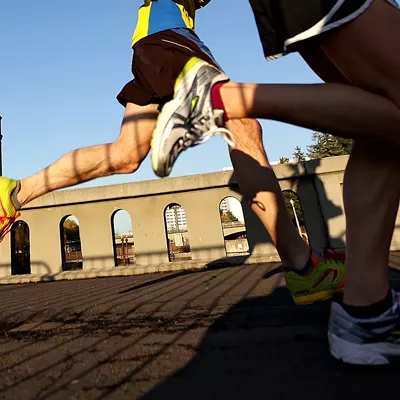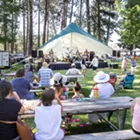
“How many virgins do we have tonight?”
Maybe 15 hands shoot up, somewhat reluctantly. And people clap — for the virgins.
Yes, great to see them. Soon they will lose their virginity.
These are runners; there is nothing sexual here, aside from a few low-cut running shirts and shorts that don’t leave much to the imagination.
The virgin question is one Brendan Dowling poses every week to the 400 (or more) people crammed into a ballroom at the Red Lion River Inn in Spokane. Virgins are people attending their first run of the Flying Irish, Spokane’s largest weekly running and social club. Indeed, it’s one of the largest running clubs in the U.S., as far as anyone knows.
This night, however, is noticeably less jovial than usual. It’s April 18, a little more than three days since the Boston Marathon bombings left three dead and hundreds injured.
Dowling, the club’s official president but better known as its “Grand Poobah,” takes time to note how as a running community, all the Flying Irish stand in solidarity with the three people killed and many hurt in Boston on Monday.
He asks for a moment of silence and reflection. Gone is Lu Lingzi, a Boston University graduate student from China.
And Krystle Campbell, 29, from Medford, Mass.
And Martin Richard, 8. He came to cheer for his dad.
Little did everyone know that about an hour after their moment of silence, another victim, MIT police officer Sean Collier, would be shot and killed.
Individual or Community?
Running is a curious sport. On one hand (foot?), it’s one of the oldest and most basic forms of athletic competition — one foot in front of the other. But on the other, it’s obscure relative to the major professional sports. Sure, big events like the Boston Marathon and Bloomsday bring out tens of thousands of runners and spectators. But there’s no comparison, in terms of popularity, to football, baseball and the like.
It also has a reputation as a solitary endeavor. Yes, there are team aspects — Spokane has some of the best high school cross-country teams in the state — but from a competitive standpoint, running is largely viewed as an individual sport. Whether a 5-kilometer fundraiser or a 26.2-mile marathon, every person training for a race will eventually hear the “running is so individual, you can’t compare yourself to others” spiel.
That may be true, but every person who runs in groups or with clubs will tell you the push of another runner from behind, or the struggle to keep up with a faster runner ahead, is immensely helpful.
There’s also an extremely important social and motivation factor gleaned from running in a community. Just ask Jody Shapiro.
Shapiro started the Manito Running Club in 2008 with his friend Mike Wiser. (Full disclosure: I’m a member of Manito and the Flying Irish.) The pair had a simple goal: Train for a half-marathon, and do it with other people for motivation and camaraderie. More than five years later, it’s paid off. Shapiro ran the 2013 Boston Marathon, setting a personal record of 2:55:21 and achieving his goal to run it in under three hours. (He was well out of the finish-line area when the two bombs went off.)
“When I think of all the friends I’ve made over the past five years, I think about how many good friends I have. I feel like this is my high school now,” says Shapiro, who’s actually 20-plus years removed from high school. “These are the people I know better than anybody else. This is my community now, all of these running groups.”
From two friends looking to help each other get back into running, Manito Running Club has grown fast in just a few years. Shapiro was joined by five other Manito runners in Boston this year.
One of those runners, Javier Pita, knows the benefits of running as a community. He was injured along the Boston route (before the bombings) and was helped by another runner who Pita says probably sacrificed his own time to render assistance.
“A lot of people have this perception that runners are selfish, but in the face of adversity, we help each other,” Pita says. “That’s why you hear stories of people after the bombing, literally ran to the hospital to donate blood.”
Pita also knows that runners don’t just help each other — they help the broader community. He experienced that firsthand last November when he arrived for the New York Marathon, canceled at the last minute due to Hurricane Sandy. Runners in town for the marathon quickly turned to helping with relief efforts, particularly on badly hit Staten Island.
Spokane-area runners stepped up after Boston to not only commemorate what happened and show support, but to help those in need here. After the Boston bombings, the Flying Irish and local running stores organized an impromptu shoe drive to donate running and athletic shoes to local homeless shelters. Dowling said the effort garnered more than 700 pairs of shoes in one week.
Solidarity
One week after the Boston bombings, hundreds of runners gathered at the “Joy of Running” statues in Riverfront Park, which have become the site of a makeshift Boston memorial, Spokane’s own sign of support. Those gathered — Runners Soul owner Curt Kinghorn helped organize the event and estimated the crowd at around 700 — would run a quick 2.62-mile route, a tenth of a marathon’s 26.2 miles.
“Thank you for coming! Thank you for running!” yelled Kinghorn above the crowd noise. “What we’re going to do now — we’re going to run!”
Anyone who ran Boston was invited to lead the run. A steady stream of clapping grew louder as the running veterans, wearing their trademark yellow Boston Marathon shirts, meandered to the front.
And then they ran, just as they had a week before, followed by several hundred of their closest running friends, around Riverfront Park, over the Spokane River to Gonzaga, across Division Street, back to where they’d started.
Each crossed the finish line on his or her own, individually. But not alone. When you run, you’re never alone.
Bloomsday Security
After the Boston Marathon, race organizers across the country scrambled to evaluate, change and strengthen their own security measures.
Three weeks after Boston, Spokane will test those measures during the 37th running of Bloomsday.
Almost immediately after the April 15 bombings, Bloomsday officials began reassessing how they’ll keep tens of thousands of runners, walkers and spectators safe. They held a press conference April 18 to discuss broader issues of how Bloomsday will honor and recognize the Boston victims.
Bloomsday security chief Al Odenthal, a retired assistant Spokane police chief, couldn’t discuss many specific details, but noted that much was going on behind the scenes to ensure a safe event, including coordination with local and federal law enforcement.
Odenthal did note that there will be stricter enforcement in the starting area corrals regarding who is let in: only people with official race bibs.
There is precedent for this kind of increased scrutiny and coordination with federal law enforcement. After the January 2011 attempted bombing of Spokane’s Martin Luther King Jr. Day parade, Odenthal said Bloomsday worked with the FBI to increase safety around the race, and that experience has prepared them for this year.
— SCOTT A. LEADINGHAM












